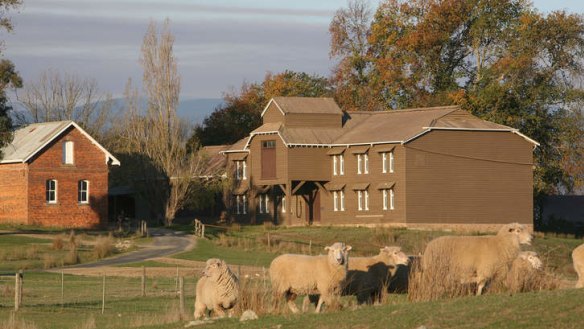Vintages stand the test of time

There's something timeless about Yeringberg, and it's not just the sign on the discreet gate at the start of the long winding driveway, nor the National Trust-classified timber 19th-century winery. It's the owners – the de Pury family – and their unhurried attitude.
The de Purys don't promote or advertise their wines and seldom exhibit in wine shows. The tiny quantities of wine have always had a ready market and it would be easy for the vineyard to be extended on the large 483-hectare property, but the de Pury family march to their own drum and expansionism is a foreign concept. Perhaps their conservatism is born of a memory of the failure of the early 20th-century Yarra Valley vineyards. It could all happen again, but that's hard to imagine today.
Because the family maintains a low-key profile, it was a rare occasion when they celebrated their 150th anniversary recently. Back-tastings of the four key Yeringberg wines were served, marsanne roussanne back to 1981, chardonnay back to 1991, pinot noir back to 1989, and the five-way bordeaux red blend, simply labelled Yeringberg, back to 1976.
Each bracket of wine amply justified its exalted reputation – although among the reds, the occasional rather green (underripe) vintage or Brettanomyces-affected bottle need not have been included. As much as I love the Yeringberg marsanne roussanne and chardonnay, and have enjoyed many a Yeringberg pinot noir, I've always considered the cabernet sauvignon-based bordeaux blend the outstanding wine. And so it proved at this tasting.
This flies in the face of Guill de Pury's reminder that the 19th-century Yeringberg was best known for its white wines.
''Yeringberg was famous for its whites, Yering for its reds, and St Huberts for both,'' he said.
In those days, the top white was the marsanne. Roussanne has been added increasingly to the marsanne since the mid-1980s and in 2012 the blend is 54/46per cent. This is a deliciously spicy, rich but refined dry white with softness and character – beautiful to drink young, but it can age superbly, as the 32-year-old 1981 vintage attested. It varies from crisp and delicate in 2011 to richly textured in 2010, and builds wonderful candied-peel and honey complexities with age.
The chardonnay is a typical restrained, refined Yarra style of moderate 12 to 13.5per cent alcohol, which also ages well. The 1991 showed superbly on the day, topped only by the 2012 – a great wine which will also reward cellaring.
The whites have been Diam-sealed since 2006, and reds since '05, which is good news, but Guill hints that screwcaps may be on the way, a radical move for a winery that has been slow to give up natural cork.
Conservatism has its upsides, though. Oak has never been obvious in Yeringberg wines, even while other makers throughout this country flirted with far too much new oak. Like the chardonnay, the pinot noir sees no more than 30per cent new oak, which ensures the fruit does the talking and the wines have good regional typicity. The pinot can be great, such as the 2005, but mostly it is merely very good – perhaps lacking slightly in detail and X-factor. But it would be surprising if the same tiny, pocket-handkerchief vineyard yielded great wine from both pinot noir and the cabernet family – Bordeaux and Burgundy in the same three hectares. In fact, the site is better suited to cabernet and friends than pinot, and the 11 vintages of Yeringberg red served at the anniversary proved this conclusively.
Their consistency of quality was impressive, notwithstanding a slightly green 1988, fusty '86 and strange '94. The other eight vintages were magnificent, notwithstanding one slightly Bretty magnum of the 1976 (the other was clean, and great). The name, simply Yeringberg, is a bit cute, invoking as it does the great chateaux of Bordeaux.
Of the top vintages, 1991, 1998, 2005 and 2010 were outstanding. Great wines all. The 2010 is 62per cent cabernet sauvignon, 11per cent cabernet franc, 10per cent merlot, 10per cent malbec and 7per cent petit verdot. It's a classic as we might expect, from a top year, but the truly surprising vintage was the 2011 – a horrendously wet season when few memorable red wines of the fuller-bodied varieties were made in southern Victoria. This wine is an exception: a very stylish wine with no sign of greener fruit characters or other wet-year problems. There's slightly less cabernet sauvignon in the blend, but no lack of intensity, weight or colour when compared with prior vintages.
According to winemaker Sandra de Pury, it was thanks to vigilance and hard work in the vineyard, and a lot of attention on the sorting table.
The 2011 shiraz is no less impressive: a marginally lighter, spicier style than usual but a beautiful fine-boned wine of satin texture. Judging by all recent releases, including one of the most difficult seasons on record, Yeringberg is in top form today.
Timeline
1863 – Swiss-born Baron Guillaume de Pury bought land from the original Yering property. He’d previously worked for the de Castellas at St Huberts. He named it Yeringberg, a blend of Aboriginal and German meaning the hill above Yering.
1880s – the timber-clad, corrugated iron-roofed winery was built.
1921 – the vines were pulled out because the market for table wine had dried up. Ironically, the final vintage won a gold medal at the Melbourne Wine Show.
1969 – Guill de Pury, the founder’s grandson, planted 0.80 hectares on the original site.
2001 – Guill and Katherine’s daughter Sandra took over as winemaker. Son David manages the vineyard.
2013 – The de Purys celebrate the 150th anniversary of Yeringberg. It has been a grazing property for 150 years and a vineyard for 102 years – 58 in the first incarnation, 44 in the second.
Prices: 2010 Yeringberg and pinot noir: both $73; 2010 shiraz: $62; 2010 marsanne roussannne and 2010 chardonnay: both $53.
